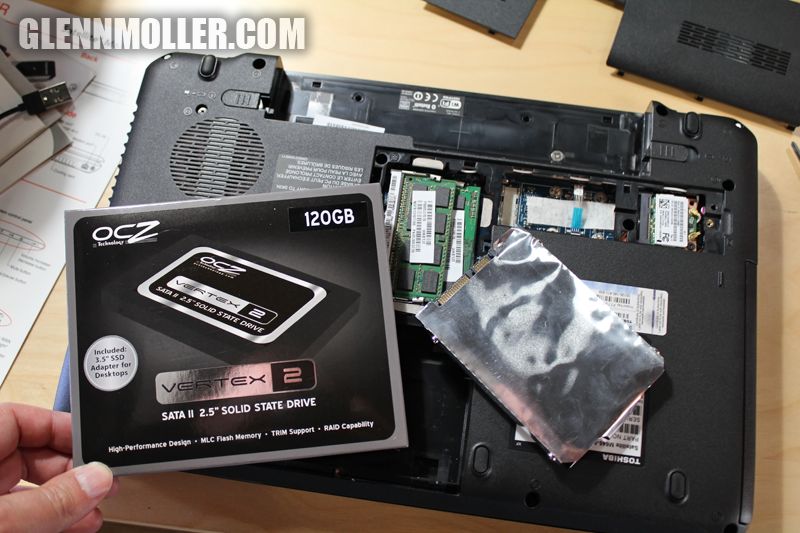OCZ Vertex 2, 120 Gig 2.5″ SSD
UPDATE: This drive failed only after 2 weeks of use. NOT ready for prime time. It was great while it lasted.
 OCZ Vertex 2 – 120 Gig 2.5″ SSD OCZSSD2-2VTXE12 SATA w/SandForce SF-1222 Controller ~ $230. I decided to throw an SSD into the Toshiba M645. I needed something that would hold all the apps I use in the field, plus a few games. Turns out 120 gigs was barely enough room. I had about 30 gigs to spare for misc files (after wiping the restore partition which I didn’t need).
For those who may not know what an SSD is, it is short for “Solid State Drive” which is a storage device that has no moving parts and stores data on memory chips instead of a hard drive which has many moving parts. They have been around for many years, dropping in price enough to use them today to replace full hard drives in computers, not just the OS or boot disk. iPad’s, USB drives, some ultra portables, many mp3 players, etc.. use some type of solid state memory to store data. For a computer however, it’s a game of offering huge storage (say 80 – 500 gigs), small form factor (able to fit in a laptop), low power consumption, fast performance, cool operation, reliable performance, and at a somewhat affordable price.
What this OCZ Vertex 2 drive brings to my laptop is blistering performance. It’s simply awesome. Everything works soooo much faster. 19 seconds to boot into windows 7. Photoshop or any other app launches in 2 seconds. Shutdowns and hibernation are much faster. Loading huge files in Dreamweaver or Office is now near instant. You can google “SSD” to see performance tests and videos showing how fast they are compared to normal HDD’s. The sandforce SF-1222 controller in this drive is pretty fast. Remember booting into windows 7 faster is one thing, but when you multiply every single HD operation, and there are many, while you work in windows the speed difference adds up and it is really noticeably faster.
OCZ Vertex 2 – 120 Gig 2.5″ SSD OCZSSD2-2VTXE12 SATA w/SandForce SF-1222 Controller ~ $230. I decided to throw an SSD into the Toshiba M645. I needed something that would hold all the apps I use in the field, plus a few games. Turns out 120 gigs was barely enough room. I had about 30 gigs to spare for misc files (after wiping the restore partition which I didn’t need).
For those who may not know what an SSD is, it is short for “Solid State Drive” which is a storage device that has no moving parts and stores data on memory chips instead of a hard drive which has many moving parts. They have been around for many years, dropping in price enough to use them today to replace full hard drives in computers, not just the OS or boot disk. iPad’s, USB drives, some ultra portables, many mp3 players, etc.. use some type of solid state memory to store data. For a computer however, it’s a game of offering huge storage (say 80 – 500 gigs), small form factor (able to fit in a laptop), low power consumption, fast performance, cool operation, reliable performance, and at a somewhat affordable price.
What this OCZ Vertex 2 drive brings to my laptop is blistering performance. It’s simply awesome. Everything works soooo much faster. 19 seconds to boot into windows 7. Photoshop or any other app launches in 2 seconds. Shutdowns and hibernation are much faster. Loading huge files in Dreamweaver or Office is now near instant. You can google “SSD” to see performance tests and videos showing how fast they are compared to normal HDD’s. The sandforce SF-1222 controller in this drive is pretty fast. Remember booting into windows 7 faster is one thing, but when you multiply every single HD operation, and there are many, while you work in windows the speed difference adds up and it is really noticeably faster.
 Installation is very easy, make sure you created recovery discs, swap the SSD drive with your normal system HD and you are done. Then just boot from your recovery media and restore your system to the new SSD. You format and treat it like a normal HD. This is better than just ghosting your existing drive since windows 7 might see your new SSD and adjust itself accordingly. I say “might” since your system may be different than mine and may not do so. Included with the drive is a metal bracket / adapter to mount the SSD in a tower or desktop computer.
There are some tweaks you can do like disabling defrag, prefetch, superfetch, setting your bios to enable AHCI, etc.. I adjusted the software settings (defrag, pretfetch, etc) but I left the controller setting in the BIOS as is so I can swap drives without forgetting to re-set it. The TRIM feature of this SSD drive also works in normal SATA / IDE mode. Again this was just my setup, speed is fast enough for me as is.
Solid State Drives are the future, at some point every computer will have one as it’s system drive or perhaps the new hybrid drives coming out will be the norm, but if you want the fastest available for your Mac or PC (for the price) you might want to swap your HDD with an SSD, but be warned… the faster performance will spoil you and you’ll want an SSD for all your computers 🙂
Installation is very easy, make sure you created recovery discs, swap the SSD drive with your normal system HD and you are done. Then just boot from your recovery media and restore your system to the new SSD. You format and treat it like a normal HD. This is better than just ghosting your existing drive since windows 7 might see your new SSD and adjust itself accordingly. I say “might” since your system may be different than mine and may not do so. Included with the drive is a metal bracket / adapter to mount the SSD in a tower or desktop computer.
There are some tweaks you can do like disabling defrag, prefetch, superfetch, setting your bios to enable AHCI, etc.. I adjusted the software settings (defrag, pretfetch, etc) but I left the controller setting in the BIOS as is so I can swap drives without forgetting to re-set it. The TRIM feature of this SSD drive also works in normal SATA / IDE mode. Again this was just my setup, speed is fast enough for me as is.
Solid State Drives are the future, at some point every computer will have one as it’s system drive or perhaps the new hybrid drives coming out will be the norm, but if you want the fastest available for your Mac or PC (for the price) you might want to swap your HDD with an SSD, but be warned… the faster performance will spoil you and you’ll want an SSD for all your computers 🙂
